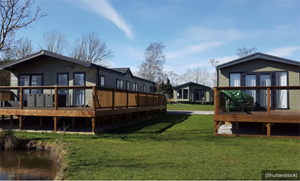 This year is the summer of “staycations” and prices have rocketed in response to huge demand. A two-bedroom park lodge in Devon, for instance, can command £1,500 per week, perhaps even more for one with a sea view.
This year is the summer of “staycations” and prices have rocketed in response to huge demand. A two-bedroom park lodge in Devon, for instance, can command £1,500 per week, perhaps even more for one with a sea view.
So, an obvious question is, why not invest in a park lodge? Rent it out for the high season to cover costs and you get the rest of the year to enjoy what should essentially be a free holiday. And you can always sell up further down the line.
 I first came across the world of park lodges when my friend Kirstie (not her real name) rang me to say she’d come across one with “an incredible sea view” in Devon. “The salesman is so helpful and charming. It’s really quick and easy to buy. He says I don’t need to use a lawyer as it’s just a chattel, like buying a car.” “How much?” I asked. “£225,000 for a 37-year-licence. But he’s really pushing me. He says someone else is interested.” Kirstie can be rather impulsive and this was worrying me. “Let me do some research,” I said.
I first came across the world of park lodges when my friend Kirstie (not her real name) rang me to say she’d come across one with “an incredible sea view” in Devon. “The salesman is so helpful and charming. It’s really quick and easy to buy. He says I don’t need to use a lawyer as it’s just a chattel, like buying a car.” “How much?” I asked. “£225,000 for a 37-year-licence. But he’s really pushing me. He says someone else is interested.” Kirstie can be rather impulsive and this was worrying me. “Let me do some research,” I said.
Wherever I looked online I read advice to the tune of: “It’s really important to use the services of a specialist lawyer. The law regarding purchase of park homes is very different to bricks and mortar. Don’t be pressurised into making a hasty decision. You should also use a specialist surveyor, in particular to check the chassis, cracks, subsidence, insulation, cladding etc. Check whether the lodge has a structural guarantee. If you are buying a used park home, ask your lawyer to look at the existing Written Statement from the outgoing occupier.”
I also ordered a free magazine called Park Lifestyle which re-iterated this advice and listed some specialist lawyers and surveyors. When I spoke to some of them, they confirmed what I’d read on-line and in the magazine.
So I asked Kirstie if she wanted me to do some more research and talk to the salesman myself. She readily agreed. I rang him and asked for a copy of the contract and sub-letting agreement and also told him that she was feeling bullied and to back off for a bit.
I spent the next couple of days trawling through the small print and became increasingly outraged at the hidden costs and the way she was being encouraged into signing away a large chunk of money without professional advice.
After my having grilled the salesman on various aspects of the documentation, Kirstie rang to tell me that the vendor had decided he wanted to hang onto the lodge after all and had withdrawn the sale. My hunch was that the salesman was finding all my questions uncomfortable and had perhaps found a more malleable potential purchaser.
Before rushing into buying one of these lodges, hoping for free holidays and a bit of extra cash through renting out in the high season, consider these facts on Kirstie’s potential purchase.
The £225,000 lodge with a 37-year-licence effectively costs just over £6,000 per year of ownership. Unlike your average bricks and mortar, this property is a diminishing asset. If you sell, you’re highly unlikely to make a profit. And if you do want to sell, the site owner might insist on approving the purchaser and they might decide to just block the sale and perhaps offer to buy it back off you at a much lower sum. (This scenario is not uncommon, although it appears to be not strictly legal according to what I’ve read.) If the site owners sell on her behalf, they would charge 15 per cent + VAT commission. If she were to sell through an estate agent and pay them a commission, she would still have to cover the site owner’s commission. I also read that: “There is an implied Term under the Mobile Homes Act (1983) that the park site owner is entitled to receive a commission on the sale of a park home at a rate not exceeding 10% of the sale price.” Note the word “implied”.
Then there are yearly fees, typically: pitch fees of £6,750, plus £1,000 sewerage and utilities, £350 rates, £300 insurance, £159 TV licence, exterior refurbishment “to be conducted by the site owner every three years at cost (unspecified), plus a management fee of 10 per cent + VAT”. Then there are “sundries”, such as winter drain-down and reconnection service (compulsory), gas and electrical safety tests, potential pest control visits, exterior wash of lodge and deck and countless other extras, no doubt many of them hidden.
So, let’s say, factoring in the £6,000 p.a. purchase price, that the lodge costs £15,000 p.a., Kirstie would get her money back through renting it out for 10 weeks in high season at £1,500 per week and get a free holiday the rest of the year.
That’s how it’s presented in their glossy sales spiel. Except that the park owner takes a whopping 30 per cent + VAT commission for letting it and Kirstie wouldn’t be allowed to let it privately or she’d be in breach of her licence agreement. Four of those weeks might produce nearer £750 per week rental income, as they’d actually be in mid-season.
There is a £300 “set-up fee” for letting the lodge. And there is more. Subletting statements, cleaning, linen hire, repairs, replacements in case of breakages (the deposit doesn’t appear to cover that), call-out charges, pre-season “deep clean”, smoke and carbon monoxide alarms, fire extinguishers and blankets, annual PAT certificate, annual gas safety certificate, fixed electrical installation certificate, WiFi and broadband. It goes on and on. And all this has to be carried out by the park owners (and their contractors) along with, naturally, a 10 per cent + VAT admin charge. I’m sure I’ve missed a load more costs.
So, it’s almost impossible to work out how many weeks you’d need to rent out your lodge before you broke even.
This is the set-up for this particular park. Each one appears to have its own rules. Some have a residents’ association which might be able to fight large increases in the yearly pitch fee but, in many cases, if you rent out your lodge you forfeit the right to be a member of the association. Many don’t have such an association, in which case it’s hard to have any say over steep increases.
You also need to check if you can have pets to stay with you and for how long, as well as any age restrictions. You can’t just give any old friend your keys to treat them to a holiday. In many cases, you can only nominate a minimal number of friends who are allowed to use your lodge.
And all this is assuming that your particular owner isn’t what’s known in the trade as a UPO (unscrupulous park owner), who might make owning your lodge into a Rachmanesque nightmare. UPOs are notorious for dumping large skips to block that sea view and carrying out heavy drilling and building work, for heaven knows how long, around your lodge. When you can’t bear the noise, the rising costs and general bullying and decide to sell up, they offer to buy your lodge back at some paltry sum, blocking any other purchasers who would need to be “approved” by them.
If all this sounds over the top, I had a long chat with Jane, an ex-lodge owner. She asked me not to reveal her real name or that of her UPO, as she was so scared of him and the potential consequences, despite no longer owning her lodge.
“We bought one for £75,000, with a 6 per cent p.a. ‘guaranteed’ rental return. The deal was that we were allowed six visits of up to a week each in the off-season. We were then expected to spend several thousand in refurbishment costs to ‘bring it up to rental standard’. The boiler went so that was another couple of thousand. The reality was that we got exactly £1,125 in the seven years we owned it. The costs were endless and we felt really cheated. We live in London and our lodge was in Devon, so it was impossible to keep a close eye on things and the park owner took full advantage of that. But we were blinded by all the beauty and rushed in without reading the small print.” Jane also fell for the line that she didn’t need to use a lawyer or surveyor.
“I put my inheritance money into the so-called investment. It turned out that the owner was using much of our rent to cover his debts. I tried to sell but he blocked three potential purchasers and then offered to buy it back at £50,000, £15,000 less than what we were offered by a private buyer. We eventually accepted his offer. I heard through one of the neighbours that he sold it on for £115,000. By that time, I’d fallen ill and just didn’t have the energy to fight him.”
I also spoke to an estate agent who had three such lodges on her books and we talked in detail about the situation. She finally admitted that the whole situation was a “money-machine” for the park owners. She also said that almost none of her clients had used a lawyer or surveyor prior to purchase and it wasn’t something she’d make a point of advising them to do.
Lodge prices do vary considerably. It all depends on the view, location, length of licence, age, condition and size of the lodge and the on-site facilities (many have indoor pools, gyms, restaurants, even free use of the local golf club). So making cost comparisons is quite complicated.
But a sensible recommendation would be to look into such a purchase very carefully and not be blinded by that magnificent sea view and the site owner’s marketing material. Pay a visit to the site and talk to as many other lodge owners as possible to get a feel of the place. Don’t believe those glossy pictures of the pool and gym, and check how good the restaurant really is. And be aware that even if you get a decent owner, they may well sell the park onto one of those dreaded UPOs.
If you’re still tempted, have a look at the PHRAA (Park Home Residents Action Alliance) website and read one document in particular: Why I Would Never Buy Another Park Home, a 50-page rant about one man’s experience of a particularly unsavoury UPO. If that doesn’t put you off, I don’t know what will.
And yet, some of those sea views are so very alluring… it’s tempting to fall for it.